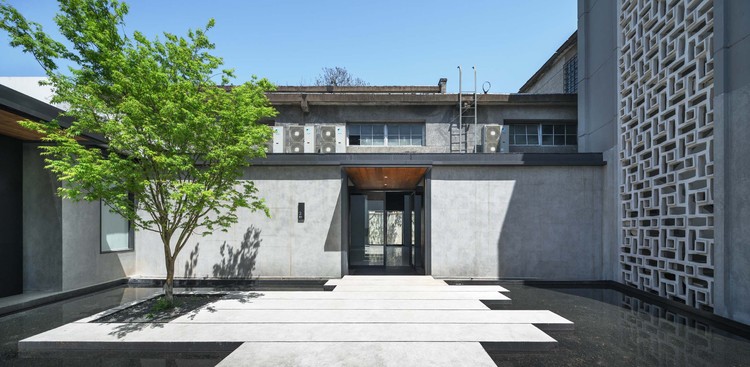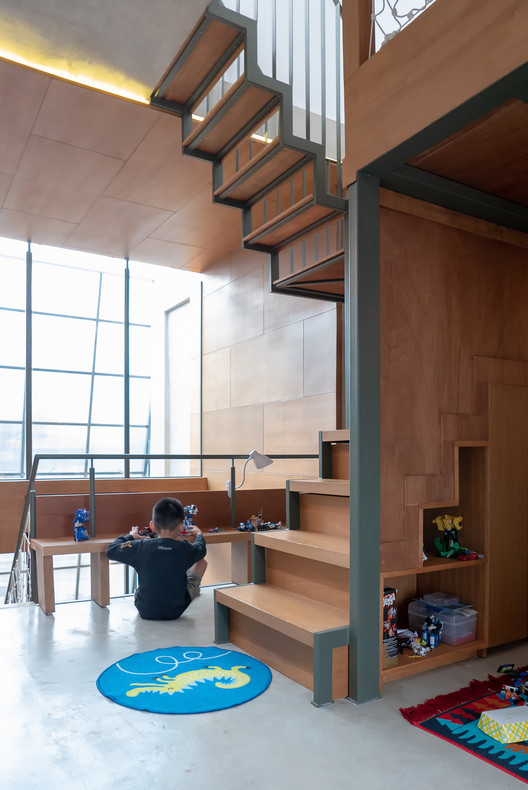Claremont University Consortium Administrative Campus LTL Architects
2013-03-20 01:00
架构师提供的文本描述。这一新的克莱蒙特大学联合会(CUC)管理校园中心(CUC)将CUC的大部分部门和服务合并成一个单一的地点,这些部门和服务以前分散在整个校园内,并且支离破碎。新的行政校园中心通过适应性地重复使用一座未被充分利用的42,000平方英尺的维护大楼,使CUC能够以一种环境敏感的方式创造一个独特和充满活力的工作环境,具有明确的公共特征,并为学院和更广泛的社区提供一个集体聚会的场所。
Text description provided by the architects. This new Administrative Campus Center for the Claremont University Consortium (CUC) consolidates the majority of CUC departments and services, previously dispersed and fragmented across campus, into a single location. Through the adaptive re-use of an under-utilized 42,000 square feet maintenance building, the new Administrative Campus Center allows CUC to create a unique and vibrant work environment with a well-defined public character in an environmentally sensitive manner, and provides a collective gathering place for both the Colleges and the broader community.
该项目部署了一系列交织在一起的、物质丰富的、战术性的建筑元素,这些元素重新规划了现有的设施并重新定义了其公共存在。这些包括一个连续的740英尺长的雪松屏幕,一个定制的天花板云,一个数字花园,和168个太阳能烟囱,通过空间提供自然光。
The project deploys a series of intertwined, materially rich, tactical architectural elements that reprogram the existing facility and redefines its public presence. These include a continuous 740 foot long cedar screen, a custom ceiling cloud, a digital garden, and a field of 168 solar chimneys that providing natural light through the space.
虽然可持续发展战略的一个主要方面是保留和再利用现有建筑,但其目前的实用外观既不吸引也不适合新用途。为了重新定义建筑物的特征,一个连续的雪松表面包裹了其北部、东部和南部的部分高地。丝带工作与现有的倾斜几何建筑,但移动离开现有的外壳,以产生一个明确界定的入口和外部聚集空间。从入口处,雪松滑进了室内,形成了一个新的接待区和咖啡馆。屏幕从咖啡厅延伸到南庭院,形成了一个非常大的多用途区域。这一地区也是由一个拉伸结构天篷与半透明拉伸织物保护不受天气影响。当这条雪松丝带穿过窗户时,雪松板的间距会逐渐增大,以允许光线进入。雪松丝带在夜间用内置的LED灯照明,它既是一种寻找道路的装置-清楚地表示建筑物进入车辆和行人交通的入口-也是CUC的新形象。
While a major aspect of the sustainability strategy is to retain and reuse the existing building, its current utilitarian exterior is neither inviting nor appropriate for the new use. To redefine the building’s character, a continuous cedar surface wraps portions of its north, east and south elevations. The ribbon works with the existing sloped geometry of the building, but moves free of the existing shell to produce a clearly defined entry and exterior gathering spaces. From the entry, the cedar slips into the interior, framing a new reception area and cafe. The screen continues from the café out to the south patio defining a very large multi-purpose area. This area is also protected from the weather by a tensile structure canopy with translucent stretched fabric. Where this cedar ribbon passes over windows, the spacing of the cedar panels is incrementally increased to allow light in. Illuminated at night with imbedded LED lights, the cedar ribbon serves as both a way finding device—clearly denoting the building’s entry to vehicular and pedestrian traffic—and a new image for CUC.
大楼内部利用现有钢结构的高天花板和大跨度,提供开放的办公空间,配有定制竹桌和家具,可供100多名员工使用。168“Solatube”天窗加上周边扩大的窗户,为所有工作站提供足够的自然光,因此白天不需要人工照明,大大降低了建筑能耗。当太阳下山时,一个高效率的可调光荧光灯的栅极慢慢地打开,保持一个恒定的光位。为了让光线进入空间,一个定制的天花板是由超过1467 9英寸x8‘挡板组成,覆盖在回收塑料瓶毡。天花板在整个建筑中形成了一个雕塑状的内部云,统一了空间,模糊了基础设施,并有助于在开放式办公室中进行声音缓解。
The interior of the building takes advantage of the both the high ceiling and the large spans of the existing steel structure, providing an open office space, with custom bamboo desks and furniture for over 100 employees. 168 ‘Solatube’ skylights in combination with expanded windows along the perimeter provide enough natural light to all work stations so that artificial illumination is not needed during the day, greatly reducing the building energy consumption. As the sun sets, a grid of high efficiency dimmable fluorescent light slowly turns on maintaining a constant light level. To allow the light to filter into the space, a custom ceiling is composed of over 1467 9” x 8’ baffles, clad in recycled plastic bottle felt. Forming a sculpted interior cloud across the entire building, the ceiling unifies the space, obscures the infrastructure, and assists with sound mitigation in the open office.
从红地毯的中央脊梁出来的是一个宽阔的楼梯,为大型聚会提供了漂白剂一样的座位。楼梯利用建筑物的天花板高度,为下面的新小厨房和上面的仙人掌花园创造空间。大楼有十一间会议室,从较小的四人工作间到32人的大型执行董事会会议室,并配有完全集成的视听系统。一个由艺术家贾森·克鲁格曼(JasonKrugman)制作的数字花园装置,由6000多个LED模块组成,包裹着中心核心,其中包括六间会议室,以及两套卫生间。LED是由人们在附近行走的运动触发的,从绿色到蓝色再到绿色的微妙转变。这一装置符合创造集体、平等的氛围的总体意图,将技术智能地运用到一个高效而富有创造性的环境中。
Emerging from a central spine of red carpet is a wide stair, which provides bleacher like seating for large gatherings. The stairs take advantage of the building ceiling height by creating space for a new kitchenette beneath and a cactus garden above. The building contains eleven meeting rooms, ranging from smaller four person work spaces to a large 32 person executive board room with fully integrated audio-visual systems. A digital garden installation, produced by the artist Jason Krugman, comprised of over 6000 LED modules, envelopes the central core which contains six of the meeting rooms, along with two sets of restrooms. The LEDs are triggered by the motion of people walking nearby, and subtlety shift from green to blue back to green. This installation is consistent with the overall intent to produce a collective, egalitarian atmosphere with intelligent use of technology into an efficient yet creative environment.
 举报
举报
别默默的看了,快登录帮我评论一下吧!:)
注册
登录
更多评论
相关文章
-

描边风设计中,最容易犯的8种问题分析
2018年走过了四分之一,LOGO设计趋势也清晰了LOGO设计
-

描边风设计中,最容易犯的8种问题分析
2018年走过了四分之一,LOGO设计趋势也清晰了LOGO设计
-

描边风设计中,最容易犯的8种问题分析
2018年走过了四分之一,LOGO设计趋势也清晰了LOGO设计














































































